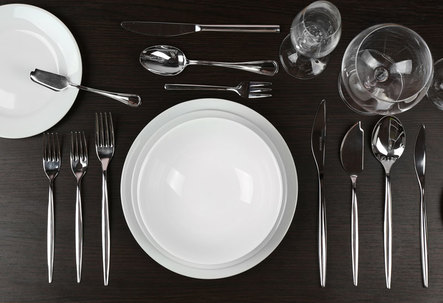 As restaurants grow increasingly creative with their menus, interiors, seating arrangements and overall business models, they’re also changing things up with the otherwise traditional place setting. The typical setup of silverware, napkin and glass atop a tablecloth is still present and commonplace, but no longer ubiquitous at full-service establishments. The reason for most of this change: cost savings. But is it worth it in the long run? Let’s take a look at a few new restaurant place setting trends and see where they work best. There’s no one-size-fits-all solution here, so the key is to match your place setting to the atmosphere and overall brand you’re trying to create. Tablecloths Tablecloths have all but disappeared from the restaurant scene, in that very few new restaurants will use them. Why? Tablecloths cost money to wash and take time to fold, set up, take off and bring to storage. Why use a tablecloth that has to be changed with every meal when it’s so much easier to wash and dry a bare tabletop? And to many young patrons, tablecloths are ‘old school’ and give the restaurant a dated feel. When to use tablecloths Tablecloths should be used in almost any true fine dining setting. White tablecloths do give off a more ‘old school’ sense while black tablecloths come off a bit more modern. If you are trying to cast an intimate, high-end atmosphere, tablecloths will boost that vibe to justify a higher price point. Many places make the mistake of skipping tablecloths as a cost-saver while not noticing the bigger problem of the atmosphere not lining up with the food. When not to use tablecloths Restaurants with a modern look and feel really don’t need tablecloths. Tablecloths would actually detract from the vibe in these cases. However, you can skip the tablecloths if and only if your tables are nice enough on their own. Centralized silverware A growing number of restaurants will pile silverware in a glass at the center of the table for patrons to set themselves. This can be a big cost saver, allowing for quicker turnover and for servers to spend more time tending to tables with customers. It can also save hours at the end of a day that are otherwise spent rolling silverware into napkins. When to use centralized silverware Use this method if you have a higher-volume restaurant with a casual ambiance and a lower price point. Roadhouse barbecue joints are a perfect example. When not to use centralized silverware If you want to convey a classy, full-service experience, you should avoid this tactic. Customers dine out not just because they want your food, but because they want to be served. If their first impression is having to set the table themselves, it may be quite off-putting. A set table conveys a sense of luxury that puts people in a more relaxed mood, prepping them to spend more and be more responsive to upsell. Communal water Communal water at the table has similar goals to centralized silverware, with even greater cost saving potential and wider acceptance. If a server greets guests with a swing-top glass bottle almost frosted over with cold water, that’s both full service and a good first impression. Communal water drastically reduces demand on bussers, and can certainly lead a restaurant to require fewer bussers overall. When to use communal water Communal water can work in almost any setting where tablecloths aren’t a necessity. Guests are much more receptive to communal water, often preferring the freedom to refill themselves over searching for a busser over and over. With establishments on the higher end of the spectrum, however, servers should come out with both the bottle and the glasses. This extra step creates another layer of service with the experience. When not to use communal water Fine dining and other settings where you want to convey full service from start to finish should come with full water service. Restaurants with higher price points, regardless of the ‘casual’ atmosphere they’re trying to create, should consider full water service as well, to reflect the financial commitment guests are making to dine there. Table place setting techniques can be great cost-savers, but should never be used to simply cut corners. Guests recognize it when a restaurant’s shortcuts undercut its price point, and very quickly and easily at that. Just be sure that your table setting tactics are in line with your restaurant brand.
0 Comments
Leave a Reply. |
AuthorBenjamin Brown is a seasoned restaurant writer and hospitality consultant, serving up SoCal's hottest food news and reviews. Categories
All
Archives
June 2021
@Foodie_Biz |
|
Home
About
Blog
Consulting Tips
Contact
Legal
|
Foodie Biz provides restaurant news and reviews for the food community, as well as consulting advice for restaurant owners and other hospitality professionals.
Contact Foodie Biz for media opportunities and freelance consulting projects. Contact Foodie Biz |



